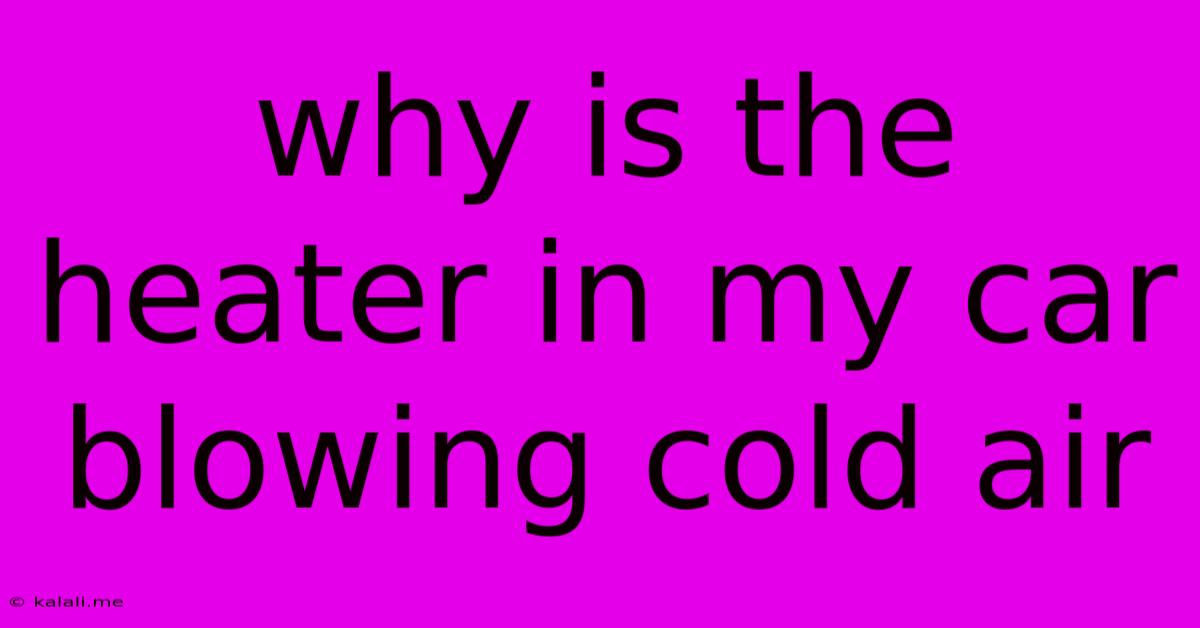Why Is The Heater In My Car Blowing Cold Air
Kalali
May 21, 2025 · 4 min read

Table of Contents
Why is My Car Heater Blowing Cold Air? A Comprehensive Guide to Troubleshooting
Is your car heater refusing to provide the warmth you need on a chilly day? A cold air blast from your vents is a common problem, but thankfully, it's often fixable without a trip to the mechanic. This comprehensive guide will walk you through the most likely causes and how to troubleshoot them. Understanding the system will empower you to diagnose the issue and potentially save you time and money.
Possible Causes of a Car Heater Blowing Cold Air:
There are several reasons why your car's heater might be malfunctioning. Let's explore the most frequent culprits:
1. Low Coolant Level: This is the most common and easiest issue to check. Your car's heater relies on hot coolant circulating through its core to warm the air. If the coolant level is low, there's not enough fluid to heat effectively, resulting in cold air.
- How to Check: Locate your coolant reservoir (often a translucent plastic tank) and check the fluid level. It should be between the minimum and maximum lines. If it's low, add coolant (make sure it's the correct type for your vehicle – consult your owner's manual). Never open the radiator cap while the engine is hot!
2. Coolant Leaks: A leak in the cooling system prevents adequate coolant circulation. This can range from a small pinhole leak to a major hose rupture.
- How to Check: Visually inspect all coolant hoses, the radiator, and the water pump for any signs of leaks (look for stains or puddles). You might also notice a sweet smell (ethylene glycol, a component of coolant, has a distinct odor). A pressure test by a mechanic might be necessary for hard-to-find leaks.
3. Thermostat Malfunction: The thermostat regulates coolant flow. A stuck-closed thermostat prevents coolant from reaching the heater core, resulting in cold air. A stuck-open thermostat will cause the engine to overheat, so this should be addressed promptly.
- How to Check: This requires a bit more mechanical aptitude. The thermostat is usually located near the engine. You'll likely need to consult your owner's manual or a repair guide for your specific car model. A faulty thermostat needs to be replaced.
4. Blocked Heater Core: Over time, debris or rust can clog the heater core, restricting coolant flow. This is less common but can lead to reduced heating efficiency or complete failure.
- How to Check: This is a more complex issue that often requires a professional. Flushing the cooling system might resolve a partial blockage. A severely blocked heater core usually needs to be replaced.
5. Faulty Heater Control Valve: This valve controls the flow of coolant to the heater core. If it's malfunctioning or stuck closed, no hot coolant will reach the heater, leaving you with cold air.
- How to Check: Checking the heater control valve often requires more mechanical expertise. You might need to consult a repair manual or have a mechanic diagnose the issue. If faulty, the valve will require replacement.
6. Blower Motor Problems: While less common, a faulty blower motor (the fan that pushes air through the vents) can cause insufficient airflow, making the air feel cold even if the coolant is hot.
- How to Check: Listen carefully for any unusual noises coming from the blower motor. If it's not working at all or producing weak airflow, the motor might need to be replaced.
7. Blend Door Issues: The blend door controls the mix of hot and cold air. If it’s malfunctioning, it may be stuck in the cold air position. This is often a more difficult issue to diagnose and repair.
- How to Check: This typically requires a professional diagnosis.
When to Call a Mechanic:
If you've checked the simple things (coolant level, obvious leaks) and still have cold air coming from your heater, it's best to consult a qualified mechanic. They have the tools and expertise to diagnose more complex problems like a faulty thermostat, blocked heater core, or malfunctioning blend door. Ignoring a heating issue, especially if accompanied by other symptoms like overheating, could lead to more serious and costly engine problems.
By systematically checking these potential causes, you’ll be well on your way to getting your car heater working properly and enjoying a warm and comfortable drive, regardless of the outside temperature. Remember to always consult your owner's manual for specific instructions and safety precautions.
Latest Posts
Latest Posts
-
How To Prove A Function Is Not Measurable
May 23, 2025
-
How To Join Two Ways For Neutral Wire
May 23, 2025
-
Rotate Tubes In Blender Without Changing Thier Diameter
May 23, 2025
-
How To Find A Stud When Stud Finder Isnt Working
May 23, 2025
-
Is It By Name Or By Name
May 23, 2025
Related Post
Thank you for visiting our website which covers about Why Is The Heater In My Car Blowing Cold Air . We hope the information provided has been useful to you. Feel free to contact us if you have any questions or need further assistance. See you next time and don't miss to bookmark.